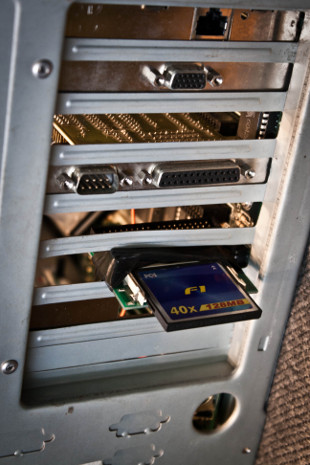80386 Silent Web Server running Linux
 As you know, the first processor that supports the Linux kernel is 80386, since Linus, the creator of this software product, started its development on this machine. On Habré, we have already discussed installing a linux distribution on a similar exhibit of computing technology, so I went further, realizing the idea of raising a web server running Linux on the 386th processor. Only one thing was frustrating - the noise, because for constant use at home this factor was negative. The decision was not long in coming ...
As you know, the first processor that supports the Linux kernel is 80386, since Linus, the creator of this software product, started its development on this machine. On Habré, we have already discussed installing a linux distribution on a similar exhibit of computing technology, so I went further, realizing the idea of raising a web server running Linux on the 386th processor. Only one thing was frustrating - the noise, because for constant use at home this factor was negative. The decision was not long in coming ...A classic motherboard with a 386 processor, 8 megabytes of a 30-pin SIMM memory, an IDE controller and a 3com network card compatible with the 3c509 module were found as the basis. Then - you need to get rid of the elements that emit sound waves.
1. Power supply.
The best option is a DC-DC power supply unit. Most of these power supplies are completely silent, because there are no moving components that produce sound - no fans. The discrepancy occurs only in the connector: on the motherboard - AT, but all modern power supplies are equipped with an ATX connector. The way out of this situation is the manufacture of an ATX adapter -> AT. According to this table - I made a similar adapter:

')
The two standard connectors are quite similar to each other, except for the fact that ATX has an additional 3.3V and a bit more GND. Such a symbiosis of two different connectors earned "a bang" - the motherboard successfully started up from an ATX-based DC-DC power supply!
2. Hard disk
The second unpleasant, eternally sounding source has identified itself as a disk storage device, a component of which, constantly rotating, emits a buzz. The CF —> IDE adapter and the old Compact Flash card from the camera at 128 MB came to the rescue, since a larger volume was firmly refused to accept the old BIOS of the experimental motherboard. Such a device, significantly reducing the audio intensity of the ether, looks like this:

Computing Sector.
Distribution lot lay on sagging Slackware, flooded the minds of penguin lovers in the 95s. The image of the system had to be notably cleaned from unnecessary packages, so that it fit into the close confines of the flash card. Unfortunately, the author of this text - the majority of modern HTTP servers were predictably hard enough to run on the obsolete 2.2 kernel, and there is very little operational memory. Only thttpd - small but remote: 70 Kb on disk and ~ 400 Kb of memory in a loaded state deigned to work in such an outdated environment. We also managed to build a Lua scripting interpreter - not surprising, since it was created for embedded systems. By linking the two components through the CGI gate, a network island that is rare for our days was formed, living in the quiet XX century.
This creation looks like this:

 ~
~ 
Undoubtedly, the whole system has worked like a clock, and the speed is very similar. (; However, unlike the clock, this mechanism is absolutely silent.
A live example is available here: 386.slogov.ru .
I think that it is not worthwhile to start thinking about what will happen with the processing speed of requests by the 80386th processor under the Habr-effect. For those who can not wait for an answer or the most impatient - I attach: screenshot of the issue .
Source: https://habr.com/ru/post/141227/
All Articles